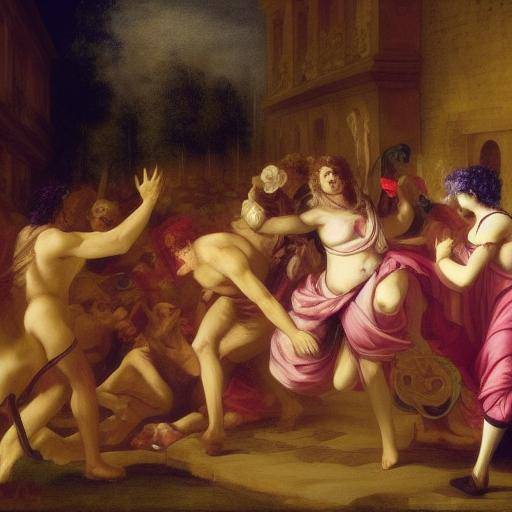
In ancient Rome, February began a unique and vibrant celebration, known as Lupercalia. This festival, marked by peculiar rituals that revolved around wolves, whips and purification, offered a fascinating view of Roman traditions. Throughout this article, we will explore in detail the history, meaning and customs associated with Lupercalia.
History and Background
The history of Lupercalia dates back to the ancient rituals of purification and fertility carried out by pre-Roman cultures in honor of the god Fauno, also known as Lupercus in the context of this festival. With the arrival of the Romans, the festival was merged with the history of Rómulo and Remo, the mythical founders of Rome, and the figure of the wolf who loved these twins.
Origins and Evolution
Lupercalia was held from 13 to 15 February and was meant to purify the city, promote fertility and ensure the protection of crops. The Luperci, priests belonging to the order of the Lupercos, played a central role in the rituals, using goat skins to whip the participants, believing that this conferred fertility and protection.
The Ritual of the Lupercal Cave
The festival began in the Lupercal cave, on the Palatina hill, where, according to legend, the Luperca wolf nursed Rómulo and Remo. Here, the Luperci sacrificed a goat and a dog, animals associated with purification. Then they joined with the blood of the sacrifices and ran through the streets of Rome whipping the passersby with goat skin strips, an act that symbolized the transfer of fertility and protection.
Proceedings and Celebrations
During the holidays, processions were carried out on the streets of the city and rituals were carried out to honor Lupercus, the protective god of the flocks and fields. The relationship with the wolf as a symbol of protection and fertility was evident, and the participants sought divine blessing through these rituals.
Transformation and Declive
While Lupercalia was a popular and entrenched celebration in Roman culture, over time he faced the opposition of religious leaders, especially with the arrival of Christianity. In the fifth century, Pope Gelasio I forbade the festival, and was replaced by the Christian holidays, such as Valentine's Day, which took some elements of Lupercalia and adapted them to the new faith.
Analysis in Deep
Lupercalia played a fundamental role in the social and religious life of ancient Rome. The rituals of purification and fertility, although often perceived as strangers by modern standards, reflected the beliefs rooted in the need for divine protection and the promotion of fertility as a basis for the success of the community.
Social and Cultural Significance
The festival also challenged social norms and promoted an atmosphere of liberation and disinhibition, as class and gender barriers were blurred during the days of celebration. Men and women participated in the scourge rituals, and physical contact in public, something normally restricted, became acceptable and celebratory.
Symbolism and Mythology
The wolf, represented by Luperca, symbolized strength, protection and fertility. The whips made of goat skin were seen as instruments of transferring these divine qualities to the participants. The blood of sacrifice and purification rituals emphasized the connection of the community with the sacred and their dependence on the gods for prosperity and protection.
The Legacy of Lupercalia
Although Lupercalia is no longer celebrated as it was in ancient Rome, its legacy remains in the modern commemoration of Valentine's Day. The rituals of purification and fertility have evolved into more romantic forms of expression, but the spirit of celebration and union persists.
Influence on Valentine's Day
The Valentine's Day, which is celebrated on 14 February, has taken elements of Lupercalia, especially in its approach to love and fertility. Although the darkest and physical aspects of Lupercalia have disappeared, the essence of human connection and the celebration of lasting affection.
Cultural preservation
The history of Lupercalia and its transformation into modern festivities underlines the ability of cultures to adapt and evolve, preserving significant elements of the past while integrating new beliefs and practices.
Conclusion
Lupercalia, with its peculiar rituals focused on wolves, whips and purification, represents a fascinating part of Roman history. Through this festival, the ancient Romans sought to ensure divine protection and promote fertility, while challenging established social norms. Although the passage of time has changed the form of these celebrations, Lupercalia's legacy continues to manifest in contemporaneity, being a tangible testimony of the cultural wealth of ancient Rome.
Final Reflection
By exploring Lupercalia, we can appreciate the depth and complexity of ancient traditions and how they have influenced our modern celebrations. The festival not only offers us a vision of religious and social life in Rome, but also reminds us of the continuity of certain fundamental human values throughout the centuries.
Frequently asked questions
- What was Lupercalia?
- Lupercalia was an ancient Roman festival held from 13 to 15 February, aimed at purifying the city, promoting fertility and ensuring the protection of crops.
- What role did the Luperci play in the holidays?
- The Luperci were priests who made sacrifices and whipped the participants with goat skin strips to give them fertility and protection.
- How does Lupercalia relate to Valentine's Day?
- Lupercalia influenced the creation of Valentine's Day, especially in its approach to love and fertility, although modern practices are more romantic and less ritualistic.
- What were Lupercalia rituals symbolizing?
- The rituals symbolized purification, fertility and divine protection, using symbols such as wolf and goat skin whips.
- Why was Lupercalia forbidden?
- Lupercalia was banned by Pope Gelasio I in the 5th century, in an effort to suppress pagan practices and replace them with Christian holidays.
